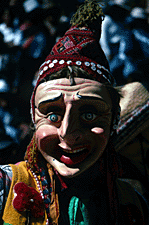|
|
 |
We mountain bike in the Andes on cobblestone roads built almost 500 years ago by the Spanish when they first came to South America. |  |
 |
Most of the people living in the Andes mountains are Indians, and many are very poor.
In northern Ecuador we visit the town of Otavalo, an area famous for hand-made textiles: beautiful weavings of blankets, clothes, wall hangings and rugs. Because of the crafts they make and sell, the Otavalo Indians have a higher standard of living. The women wear beautiful jewelry. Thier necklaces are often made from glass beads, and they have thick red coral necklaces and bracelets. Many people have gold caps in their teeth. To see more photos click on Otavalo, Ecuador. |
|
|
| Although many of the Indians in the Andes can speak Spanish, their main language is Quechua.
In many ways their lives have changed little in the last few hundred years. Most of the people farm and raise animals, including sheep, goats, pigs and chickens. In small and often remote villages in the Andes we see numerous festivals and celebrations. The man on the right is wearing a mask carved from wood and then painted by hand. To see more photos of masks and dancers, click on a Festival in the Andes. |
 |
|
Shortly after their arrival, the Spanish fought the Inca, who at the time controlled the largest empire in South America. The Inca capital was centered near present day Cuzco, Peru.
The Spanish tore down many Inca cities and used the rocks to build their own buildings and churches. To see more Inca stonework, and learn about their fight with the Spanish, click on Inca history. |
| The most famous of the Inca cities is Machu Picchu in Peru.
Tass spent three days hiking to these Inca ruins in 1975, before she met Bruce, with her friend Suzanne. To see more photos of these amazing ruins, click on Machu Picchu. |
 |
|
Please return soon for more pictures and stories from South America. |






